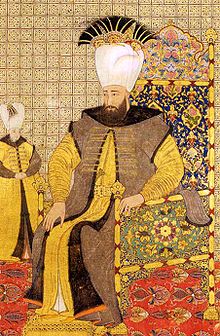
Back Ahmet III Afrikaans أحمد الثالث Arabic احمد التالت ARZ III Əhməd Azerbaijani اۆچونجو احمد AZB Әхмәт III Bashkir Ахмэд III BE-X-OLD Ахмед III Bulgarian Ahmet III Breton Ahmed III BS
| Ahmed III | |||||
|---|---|---|---|---|---|
| Ottoman Caliph Amir al-Mu'minin Custodian of the Two Holy Mosques | |||||
 Miniature by Abdulcelil Levni | |||||
| Sultan of the Ottoman Empire (Padishah) | |||||
| Reign | 22 August 1703 – 20 September 1730 | ||||
| Predecessor | Mustafa II | ||||
| Successor | Mahmud I | ||||
| Born | 30 December 1673 Hacıoğlu Pazarcık, Ottoman Empire | ||||
| Died | 1 July 1736 (aged 62) Constantinople, Ottoman Empire | ||||
| Burial | Tomb of Turhan Sultan, Istanbul, Turkey | ||||
| Consorts | Mihrişah Kadın Rabia Şermi Kadın Musli Kadın others | ||||
| Issue Among others | |||||
| |||||
| Dynasty | Ottoman | ||||
| Father | Mehmed IV | ||||
| Mother | Gülnuş Sultan | ||||
| Religion | Sunni Islam | ||||
| Tughra |  | ||||
Ahmed III (Ottoman Turkish: احمد ثالث, Aḥmed-i sālis; 30 December 1673 – 1 July 1736) was sultan of the Ottoman Empire and a son of sultan Mehmed IV (r. 1648–1687). His mother was Gülnuş Sultan, originally named Evmania Voria, who was an ethnic Greek.[1][2][3][4][5] He was born at Hacıoğlu Pazarcık, in Dobruja. He succeeded to the throne in 1703 on the abdication of his brother Mustafa II (1695–1703).[6] Nevşehirli Damat İbrahim Pasha and the Sultan's daughter, Fatma Sultan (wife of the former) directed the government from 1718 to 1730, a period referred to as the Tulip Era.
During the initial days of Ahmed III's reign, significant efforts were made to appease the janissaries. However, Ahmed's effectiveness in dealing with the janissaries who had elevated him to the sultanate was limited. Grand Vizier Çorlulu Ali Pasha, whom Ahmed appointed, provided valuable assistance in administrative affairs and implemented new measures for the treasury. He supported Ahmed in his struggles against rival factions and provided stability to the government. Ahmed was an avid reader, skilled in calligraphy and knowledgeable on history and poetry.
- ^ Freely, John (2001). The lost Messiah. Viking. p. 132. ISBN 0-670-88675-0.
He set up his harem there, his favourite being Rabia Giilniis Ummetiillah, a Greek girl from Rethymnon on Crete
- ^ Bromley, J. S. (1957). The New Cambridge Modern History. University of California: University Press. p. 554. ISBN 0-521-22128-5.
the mother of Mustafa II and Ahmed III was a Greek
- ^ Sardo, Eugenio Lo (1999). Tra greci e turchi: fonti diplomatiche italiane sul Settecento ottomano. Consiglio nazionale delle ricerche. p. 82. ISBN 88-8080-014-0.
Their mother, a Greek, lady named Rabia Gülnûş, continued to wield influence as the Valide sultan - mother of the reigning sultan
- ^ Library Information and Research Service (2005). The Middle East. Library Information and Research Service. p. 91.
She was the daughter of a Greek family and she was the mother of Mustafa II (1664–1703), and Ahmed III (1673–1736).
- ^ Baker, Anthony E; Freely, John (1993). The Bosphorus. Redhouse Press. p. 146. ISBN 975-413-062-0.
The Valide Sultan was born Evmania Voria, daughter of a Greek priest in a village near Rethymnon on Crete. She was captured by the Turks when they took Rethymnon in 1645.
- ^ One or more of the preceding sentences incorporates text from a publication now in the public domain: Chisholm, Hugh, ed. (1911). "Ahmed III.". Encyclopædia Britannica. Vol. 1 (11th ed.). Cambridge University Press. p. 431.
© MMXXIII Rich X Search. We shall prevail. All rights reserved. Rich X Search